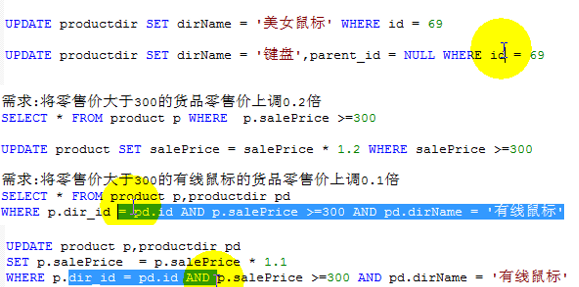一. 插入
1. 全字段插入
(1). 标准格式
insert into tableName (c1,c2,c3 ...) values (x1,x2,x3,...)
可以省略:
insert into tableName values (x1,x2,x3,...)
(2). 插入多条数据
insert into LoginRecords values('0003','1','中桥','xx.xx.xx.x','2020-03-26'), ('0004','1','中桥','xx.xx.xx.x','2020-03-26'), ('0005','1','中桥','xx.xx.xx.x','2020-03-26'), ('0006','1','中桥','xx.xx.xx.x','2020-03-26');
PS:全字段插入的时候可以省略字段名称。
2. 部分字段插入
(1). 标准格式
insert into tableName (c2,c3 ...) values (x2,x3,...)
PS:不能省略字段名称。
(2). 插入多条数据
insert into LoginRecords (id,userId) values('0007','1'), ('0008','1'), ('0009','1'), ('00010','1')
3. 插入查询结果
insert into table1 (x1,x2) select c1,c2 from table2 where condition
注:没有values关键字哦
二. 删除
1. delete关键字
delete from tableName where condition
2. truncate关键字
truncate tableName
PS:truncate是删除全表,和delete删除全表而言,如果是自增主键,truncate 后从1开始,delete后还要接着原先的自增。

三. 更新
1. 单表更新
update tableName set x1=xx [, x2=xx] where condition
2. 关联表更新
(1). SQLServer
update table1 set table1.x1='abc' from table1 join table2 on table1.id=table2.uId where condition
(2). MySQL
update table1,table2 set table1.x1='abc' where table1.id=table2.uId
eg: 可以同时更新多张关联表的数据
update T_SysUser u,T_SysLoginLog l set u.userPhone ='111111',l.userName='ypf' where u.id=l.userId and u.id='1'
3. 案例

!
- 作 者 : Yaopengfei(姚鹏飞)
- 博客地址 : http://www.cnblogs.com/yaopengfei/
- 声 明1 : 如有错误,欢迎讨论,请勿谩骂^_^。
- 声 明2 : 原创博客请在转载时保留原文链接或在文章开头加上本人博客地址,否则保留追究法律责任的权利。